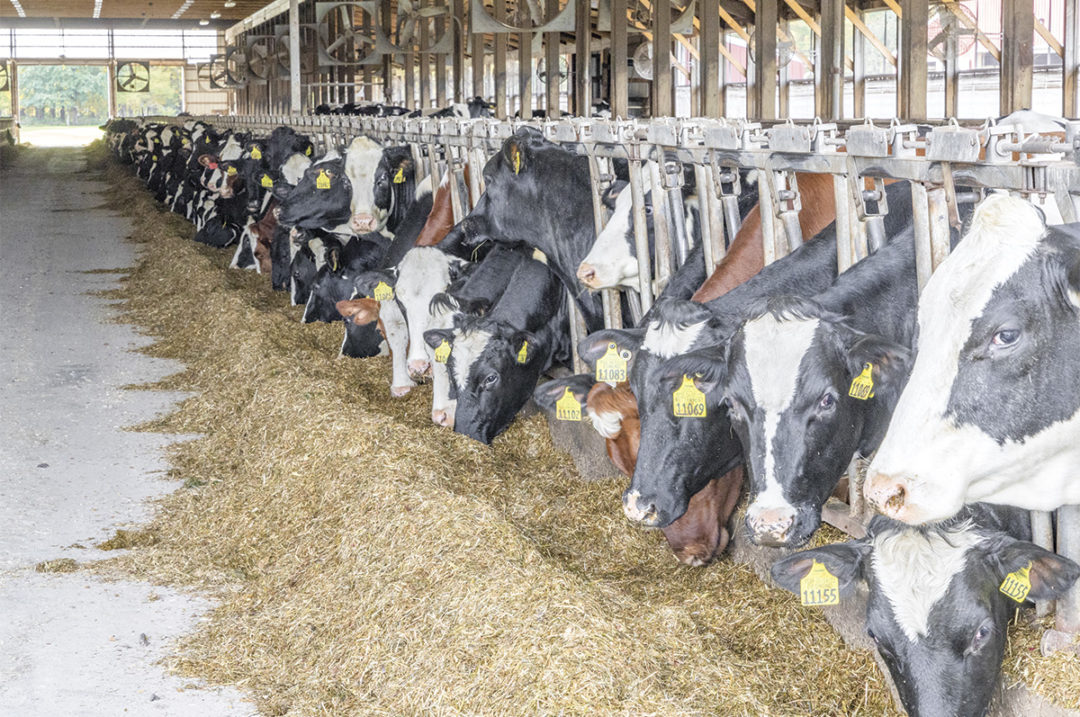Feed efficiency is frequently discussed in the dairy industry, but the financial impact of improving feed efficiency is often ignored. This may be due to a lack of understanding or a lack of data to make improvements.
Accurately measuring feed efficiency requires accurate dry matter intake (DMI) and milk production data. Current feed costs, including forage costs, are necessary for calculating economic returns.
When attempting to improve profitability on-farm, there are two main strategies – increasing milk production or lowering feed costs. In today’s dairy market, many farms cannot increase milk production due to quotas that limit the total milk shipped off the farm. Efforts to reduce feed costs by making the diet less expensive can result in decreasing milk production, which reduces income by more than the feed cost savings.
Another alternative to increase profitability is to focus on feed efficiency, making the same pounds of energy-corrected milk (ECM) with reduced DMI.
As an example, Table 1 compares Farm A to Farm B. While both farms have the same ECM production and feed cost per pound of dry matter, Farm B shows improved feed efficiency, leading to an increase in profitability of over $1.4 million.

While genetics and management components can also factor into improving feed efficiency, there are numerous nutrition and diet strategies that can be readily incorporated into your feed program to make dramatic changes in feed efficiency.
- Feed cows for exceptional rumen function. Match the concentration and rate of digestion of rumen-available carbohydrates and rumen-available protein to improve rumen microbial growth efficiency. This will maximize the microbial populations in the rumen, leading to improvements in the digestion of forage fiber in the rumen.
- Avoid overfeeding rumen-available starch and sugar to limit the risk of low rumen pH (rumen acidosis). Low rumen pH will kill fiber-digesting bacteria, lowering feed efficiency as fiber will pass through the cow undigested. While discussions about the negative consequences of acute and subacute rumen acidosis are not new, researchers have more recently determined additional post-ruminal inflammatory and digestive challenges that can occur as a result of rumen acidosis, making careful management of rumen health even more prudent.
- Avoid overfeeding rumen active fat, as this can also kill or reduce the population of fiber-digesting bacteria. A meta-analysis of the effects of adding fat to dairy cow diets reported a 5% reduction in total tract neutral detergent fiber (NDF) digestibility for cows fed oil fat supplementation, likely related to changes in the rumen microbial profile caused by bio-active fats.
- Avoid overfeeding undigested NDF (uNDF240). If a large portion of the diet is undigestible fiber, the cow must eat more to meet her energy needs, reducing feed efficiency. The diet must be made up of highly digestible fiber to properly feed the rumen and improve feed efficiency. A survey of Wisconsin farms demonstrated that a one-unit increase in uNDF in corn silage resulted in 1.3 pounds less ECM per day. These results are consistent with others who reported that increasing NDF digestibility by one unit led to a 0.6-pound increase in 4% fat-corrected milk production. Grant and others at the Miner Institute also demonstrated that cows fed a low uNDF240 diet produced almost 2 pounds more ECM than cows fed high uNDF240 diets.
- Increase the energy density of the diet. A cow will eat to meet her energy needs. Energy-dense diets require fewer pounds of dry matter to meet the cow’s requirements and let the cow produce as much milk as her genetic potential and management will allow. Strategies to increase energy density in the total mixed ration (TMR) include increasing starch, sugar and/or fat levels while reducing uNDF240.
- Maintain adequate rumen retention time to allow for digestion by managing particle size of the TMR. Increasing the passage rate by reducing the particle size of the TMR can result in a reduction in feed digestibility, thus reducing feed efficiency.
- Evaluate the bypass starch level in the diet. While the industry is focused on rumen-available starch and sugar, there is an advantage to increasing post-ruminal starch digestion. Over 30 years ago, researchers discussed the positive implications of shifting the site of starch digestion post-ruminally, citing the potential for improved efficiency. Post-ruminal starch digestion produces glucose, which can be absorbed by intestinal tissue providing energy to the cow, sparing endogenous glucose for milk production. More recently, others have discussed post-ruminal starch digestion as a benefit for improving DMI, production and rumen health.
Improving feed efficiency can mean millions of dollars to dairy operations each year. If a dairy has room for improvement in feed efficiency, working closely with a nutritionist about these diet concepts can lead to dramatic improvements in their bottom line.
References omitted but available upon request by sending an email to the editor.









